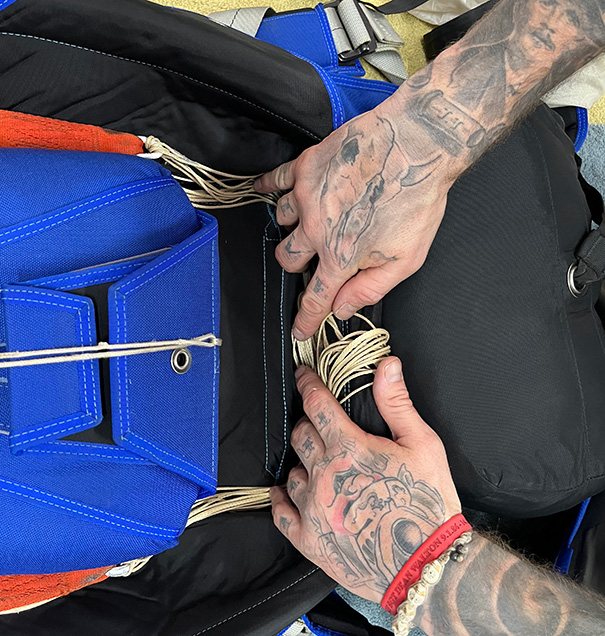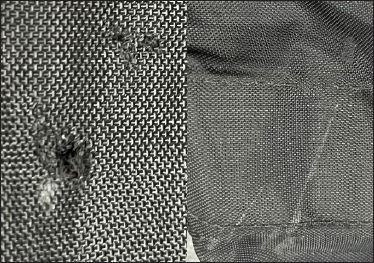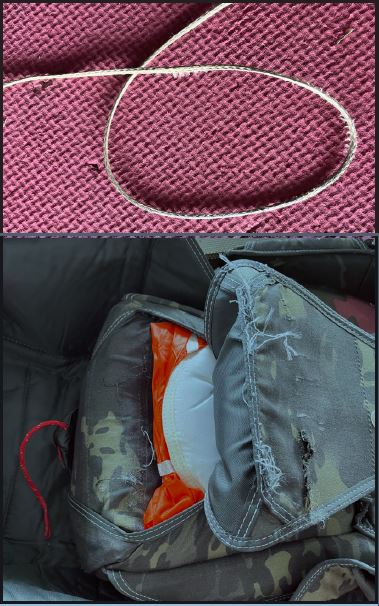 Sun Path Products representative Steve Simpson demonstrates how to correctly deal with the excess line between the ends of the risers and the last line-stow bight or semi-stowless pouch.
Sun Path Products representative Steve Simpson demonstrates how to correctly deal with the excess line between the ends of the risers and the last line-stow bight or semi-stowless pouch.When choosing how much line to leave unstowed when packing your main, there is a sweet spot to prevent unwanted results. Some of those undesirable results are just ornery line-twists and other funkiness, but others can be downright deadly, such as hard openings or horseshoe malfunctions.
When your pilot chute extracts the deployment bag from the main container, it leaves a void for the surrounding hurricane to fill. Any loose lines explode into high-speed spaghetti looking for a way to make a knot or cinch around a flapping container flap. (Why do you think they’re called flaps?) So, you’d think you’d want to stow as closely as possible to the connector links to keep loose line to a minimum. But, no, not exactly.
On most rigs, the reserve container bulges out at the bottom as it encroaches into the main container. That bump on each corner, kind of like a very hard pillow, has been known to capture lines underneath, especially during a head-high deployment. That can spin the bag and result in a line twist, lead to a bag lock if coupled with a weak pilot chute or (as has happened) actually peel the entire reserve container off the backpad. A couple of container manufacturers have placed little triangular fences to prevent problems at this interface. Check out the Aerodyne Research Icon or Firebird Evo as examples.
Keeping the loose lines away from the reserve container is also another reason why you want to deploy flat to earth with either neutral or slightly positive forward movement.
 This damage to a semi-stowless bag, which had no retention method on the open end, resulted when the loose lines wrapped around it. Fortunately, this did not result in a bag lock. The owner never noticed the damage.
This damage to a semi-stowless bag, which had no retention method on the open end, resulted when the loose lines wrapped around it. Fortunately, this did not result in a bag lock. The owner never noticed the damage.So, specifically, you want to place the lines from the ends of the risers straight along the sides of the main container to the corners, then make a 90-degree turn in the straightest line to the center and over to the last line-stow bight. What little loose line remains should be neatly crossed as needed, folded into the bottom of the container and compressed when you insert the deployment bag, which should keep them there until launch time.
Some manufacturers may not want to hear this, but most published instructions largely ignore this point of packing. At best, they disagree. Scope out some following examples:
- Aerodyne Research Icon: 23”-27” (60-70 cm)
- Firebird Evo: 12”-24”
- Mirage Systems: 12”-15”
- Parachute Laboratories Racer 8”-15”
- Parachute Systems Vortex: not specified
- Peregrine Manufacturing Glide: 12”-16” (30-40 cm)
- Rigging Innovations Curv and Talon: 18”
- Sun Path Javelin: 12”-18”
- Velocity Sports Equipment Infinity: 15”-18”
- Skydive Wings: 12”
- Strong Enterprises Quasar: 18”
- United Parachute Technologies Vector: no more than 15”-20”
 This semi-stowless bag with an open mouth and no retention method led to this jumper’s center A-line (note the burned line) looping around the mid-flap of his container. Had it not detached the panel—only the reserve closing loop and ripcord pin kept it in place—it may have been impossible to cut the malfunction away.
This semi-stowless bag with an open mouth and no retention method led to this jumper’s center A-line (note the burned line) looping around the mid-flap of his container. Had it not detached the panel—only the reserve closing loop and ripcord pin kept it in place—it may have been impossible to cut the malfunction away.That’s a range of 8 to 27 inches with a variance from the same manufacturer of between 0 and 12 inches. If the range is to account for different riser lengths and the different main and reserve containers, the purpose and ultimate positioning of the unstowed lines isn’t addressed. In addition, unless the deployment bag has a rubber band in the center for the last bight you stow (such as on Mirage and Infinity, for example), the positioning of lines from one side to another will vary the entire width of the main container.
One advantage of a semi-stowless deployment bag, where only the closing stows are rubber-banded and the rest neatly folded in a pouch on the back of the deployment bag, is that you can control the exact length of loose line in the container. However, semi-stowless bags must retain the lines in the pouch so they pay out in good order, and they’re not for every rig or every jumper. In any case, some semi-stowless pouches completely neglect this important retention feature with a wide-open mouth. That’s inviting all the lines to dump into the hurricane as the bag takes off without them. (Bad idea: See the accompanying photo of a detached flap.)
Manufacturers generally recommend between 1 ½ and 3 inches for the amount of bight past the stow band, depending on the lines and what’s necessary to get the desired release tension of 8-to-12 pounds. Another good reason to pack for yourself: You can adjust the length of each line bight as you stow, anticipating what will remain. The difference between an OK pack job and a great pack job is having the unstowed lines come out just the right length for your rig.
If you’re not paying attention to the unstowed lines, maybe you’ll get lucky and nothing will ever tangle up. But luck greatly favors those who don’t rely on it.
Kevin Gibson | D-6943 and FAA Designated Parachute Rigger Examiner
Rahlmo's Rigging at Skydive Orange in Virginia